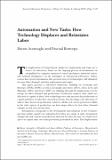Automation and New Tasks: How Technology Displaces and Reinstates Labor
Author(s)
Acemoglu, K. Daron; Restrepo, Pascual
DownloadPublished version (692.1Kb)
Terms of use
Metadata
Show full item recordAbstract
We present a framework for understanding the effects of automation and other types of technological changes on labor demand, and use it to interpret changes in US employment over the recent past. At the center of our framework is the allocation of tasks to capital and labor—the task content of production. Automation, which enables capital to replace labor in tasks it was previously engaged in, shifts the task content of production against labor because of a displacement effect. As a result, automation always reduces the labor share in value added and may reduce labor demand even as it raises productivity. The effects of automation are counterbalanced by the creation of new tasks in which labor has a comparative advantage. The introduction of new tasks changes the task content of production in favor of labor because of a reinstatement effect, and always raises the labor share and labor demand. We show how the role of changes in the task content of production—due to automation and new tasks—can be inferred from industry-level data. Our empirical decomposition suggests that the slower growth of employment over the last three decades is accounted for by an acceleration in the displacement effect, especially in manufacturing, a weaker reinstatement effect, and slower growth of productivity than in previous decades. ©2019
Date issued
2019Department
Massachusetts Institute of Technology. Department of EconomicsJournal
Journal of Economic Perspectives
Publisher
American Economic Association
Citation
Acemoglu, Daron and Pascual Restrepo, "Automation and New Tasks: How Technology Displaces and Reinstates Labor." Journal of Economic Perspectives 33, 2 (Spring 2019): 3-30 doi. 10.1257/jep.33.2.3 ©2019 Authors
Version: Final published version
ISSN
1944-7965